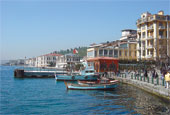 |
| Istanbul |
With its vibrant mix of the old and the new, the Eastern and the European, and the religious and the secular, Turkey is a land of contradictions and surprises. Historically, Turkey has seen the rise and fall of a number of empires and civilisations, each of which left their mark on the culture of the modern-day nation. Among predominantly Islamic nations today, Turkey?s position is unique given its secular government.
The very names of Turkish provinces and cities are full of evocative resonances that take one back to the days of the Orient Express that chugged its way through Asia on its way to Europe. Thanks to its unique geography, Turkey, the middleman between the two continents, is the best place to sample the best of both the worlds.
Turkey is divided into several geographical regions ? the main ones being the Mediterranean, the Aegean, the region around the Black Sea, Central Anatolia, eastern and south-eastern Anatolia and Thrace and Marmara. While all these have their unique attractions, touring the entire nation can?t be done in one trip. A number of tour operators in India run tour packages in Turkey and this also happens to be the best time to visit the country ? not only in terms of weather but the special Turkish Airlines flight offer that gives you a return ticket to the country (Delhi-Istanbul-Delhi) for Rs 26,960 plus taxes (valid till March 31).
Istanbul
• The erstwhile capital of Turkey, the magical Constantinople is the only city in the world that straddles two continents ? Asia and Europe. Istanbul?s history dates back to 1000 BC and it has been the capital city of two major empires ? the Eastern Roman Empire and the Ottoman Empire. Today, the two continents, Europe and Asia, are linked by two bridges near the city ? the Bosphorus Bridge and The Fatih Sultan Mehmet Bridge.
Istanbul is a chaotic city teeming with history and monuments ? mosques, churches, synagogues, castles, palaces, temples and other architectural legends representing different civilisations and cultures. At the same time, it is a modern city with a vibrant nightlife and world-famous clubs, restaurants, caf?s, shopping malls and marinas. A walk throught the busy shopping and entertainment district of Istiklal in central Istanbul is not to be missed.
You can begin your tour of the city with its monuments. There is the Topkapi Palace that dates back to Ottoman times. Now converted into a museum, it was the residence of the sultans from the 15th century until the early 1800s.
The other must-see is the famous church-turned-mosque-turned-museum, the Aya Sofia. The first church of Hagia Sophia (meaning ?divine wisdom?) was planned by Constantine the Great, but it was built by his son and heir, Constantius . For almost a thousand years Hagia Sophia served as the cathedral of Constantinople of the Byzantine Empire. Later, it was converted into a mosque at the Turkish conquest of Istanbul by Sultan Mehmet the Conqueror in 1453. The building, used as a mosque until 1934, was converted into a museum by Kemal Ataturk, founder of the modern Republic of Turkey.
Close to Aya Sofia is the Sultanahmet or the Blue Mosque. Most of Istanbul?s important buildings are located in the Sultanahmet area like the Hippodrome, Kapali Carsi (covered market), Yerebatan Sarnici and the Museum of Islamic Art.
Izmir
• Izmir, Smyrna of old, was established in the third millennium BC, when it shared with Troy the most advanced culture in Anatolia. In the first millenium BC, Izmir, ranked as one of the most important cities of the Ionian Federation. The city today lies at the head of a long, narrow gulf and is the third largest city in Turkey, its port being second in importance only to Istanbul. It is a typical tropical town with palm-lined avenues that follow the shoreline, beyond which the city gently ascends the slopes of the surrounding mountains. It plays host to the famous International Arts Festival (June/July) and the International Fair (August/September), when the whole city takes on a carnivalesque atmosphere.
Globetrotters say there is so much to do and see in Izmir that a lifetime wouldn?t be sufficient. You can begin your visit with a tour of its museums such as the Archaeological Museum that houses a superb collection of antiquities including ancient Greek statues of Poseidon and Demeter. Next door is the Ethnography Museum that contains folkloric artefacts and a collection of Bergama and Gordes carpets.
For archaeology buffs, the excavations at Bayrakli near the city is a must-see ? it is here that a temple dedicated to Athena and the wall of the Ionian city which flourished there between the seventh and fifth centuries BC was unearthed. On Kadifekale (Mt. Pagos) stand the impressive ruins of a castle, built by Lysimachus in the reign of Alexander the Great, which continues to dominate the Izmir skyline today. The castle also offers a magnificent view of the Gulf of Izmir.
History-lovers would love the Agora (marketplace) in the Namazgah Quarter, originally built during Alexander?s rule. What remains today dates from a rebuilding under Marcus Aurelius after an earthquake in 178 AD
The symbol of Izmir, the Saat Kulesi (clock tower) stands in the heart of the city at Konak Square. A gift from Sultan Abdulhamid, it was built in 1901 in an elaborate late Ottoman style. Of the many mosques, the Hisar Mosque is the largest and oldest in Izmir. Built in the 16th century, it has a delightful interior with an interesting mimber (pulpit) and mihrab (niche showing the direction to Mecca).
In the evenings, attending a performance by the Aegean Philharmonic Orchestra is highly recommended. The bars and caf?s around Kordonboyu, Passport Pier and Karsiyaka give Izmir a happening nightlife.
 |
| Bodrum |
The Mediterranean Coast
• Turkey?s Mediterranean coast is a veritable history lesson in itself, what with the major cities of cultural and historical importance that dot the shoreline. It is also a haven for beachcombers, with its sandy beaches and vistas of rugged hilly beauty.
In the ancient Lycian region, west of Antalya, you can experience the beauty of the mountain cities of Termessos and Arikand, as also coastal towns like Olimpos, Kekova and Kas. The ancient cities of Perge, Aspendos and Side are on the coastal plain east of Antalya, originally called Pamphylia.
Antalya is one of Turkey?s best vacation spots with the Konyaalti and Lara beaches to the west and east. The symbol of this city, founded in the 2nd century BC, is the Yivli Minaret from the Seljuk era. West of Antalya is the holiday town of Kemer, famous for its beaches. The next big town east of Antalya is the port city of Alanya.
Also in order is a visit to the ancient city of Ephesus ? the grandest of Turkey?s many classical cities. Ephesus was Ionia, a cultural centre during the Greek Empire, and a provincial capital during Roman times. A tour of the ruins here is a must.
The Aegean Coast
• Herodotus said of the Aegean that it ?has the most beautiful sky and the best climate in the world?. This is as true today as it was in the 5th century BC. The bays, peninsulas and golden beaches that stretch the length of the coastline were witness to history, and the best part of Greek mythology is centred around this coast. There are remains of ancient cities, including what is believed to be Troy and Pergamum, the art and cultural centre and capital of one of the most powerful kingdoms at the time.
To the south are countless resorts and further south is Foca while Sardis, the capital of the Lydian king, Croesus, is a small detour inland.
Bodrum (ancient Halikarnas and the birthplace of Herodotus) is one of the prettiest cities along the southern Aegean coast. In typical Turkish style, Bodrum is a curious mix of the old and the new. This ancient city is now home to countless pubs and nightclubs and has a thriving night-life.
Nearby, Marmaris is a lively resort with a marina surrounded by mountains and crystal-clear waters. Further south is the bay of Oludeniz and the coastal town of Fethiye, which has some of the best beaches in Turkey.
 |
| Istiklal |
Central Anatolia
• This region is the heart of modern Turkey?s political life. Ankara, the modern-day capital, is located in the middle of Central Anatolia. The most impressive structure here is the Anitkabir mausoleum built for Ataturk. The Museum of Anatolian Civilisations is among the best in the country, and has exhibits dating from 5000 BC to the 2nd century AD.
The surrounding regions bear testimony to the splendours of the Hittite civilisation, with important Hittite centres such as Hattushash (now Bogazkale) and Shapinuva, both located in the province of Corum. Reliefs of all of the Hittite gods and goddesses can be seen in the open-air temple in nearby Yazilikaya. Alacahoyuk is another important settlement known for its sphinxes.
Around 1200 BC, the Phrygians came to the Anatolian Plateau from Europe and established their capital, Gordion, near Polatli west of Ankara. Alexander the Great was supposed to have become the ruler of Asia by virtue of ?undoing? Gordion?s knot with his sword. The tomb of the legendary Phrygian king Midas, he of the golden touch, is located near Gordion.
Handy hints
 |
| Hagia Sofia |
• Besides visiting Turkey?s magnificent mosques, museums and castles, there?s a lot more you can do here, depending on where your interests lie ? whether you dig water sports, trekking, archaeology, night-clubbing or the world?s hottest dance form today, belly dancing.
Turkey boasts of many beautiful beaches, the best ones being Patara and the ??deniz beach in Fethiye and the Olimpos and Side in Antalya. Avenues for watersport aficionados are abundant at any of these. There?s also plenty for mountain-climbing enthusiasts in Turkey, and most of the activity is concentrated at Bursa, on Mt Erciyes near Kayseri, and at Paland?ken near Erzurum.
Turkey also offers several low-cost cruises, the most famous being the Blue Voyage cruise along the Aegean or Mediterranean shores. The favoured boat is the Turkish gullet, roomy motor-sailers built for comfort (not speed). While mid-July through mid-September is peak season, May and late September are cheaper on the pocket.
Cycling through Turkey is also an option. When in the country, contact the Turkish Touring and Automobile Association for maps and details.
Must-dos in Turkey
 |
• A large number of visits to the numerous flea markets that dot each big city in Turkey is a must. There?s no end to the surprises you can encounter here and the bargains you can land. From old sea chests to colourful parakeets to so-called antique carpets, you can get anything here for a price. Haggling is a must ? it?s also a good idea to take a local along.
• Looking for cheap souvenirs to take back home? Look no further than the Evil Eye charms, amulets, bracelets, wall-hangings and chimes that are all the craze right now. Known locally as Boncuk, (pronounced ?bon-dschuk?), Evil Eye charms are made of glass or stone and are supposed to protect you from the envious. Use it as a fashion statement if you find the superstition distasteful.
• A long luxurious Turkish bath in a Hamam is definitely called for. There are a number of public bath-houses in the bigger cities, many of which date back to medieval times.
• A visit to a Turkish coffee house or ?kahve? will give an insight into the Turkish way of life. Even the smallest village in the country has at least one kahve, complete with tiny ceramic cups of steaming coffee and hookahs.











